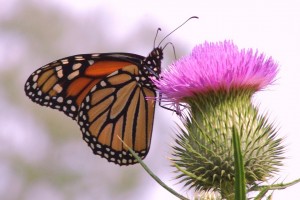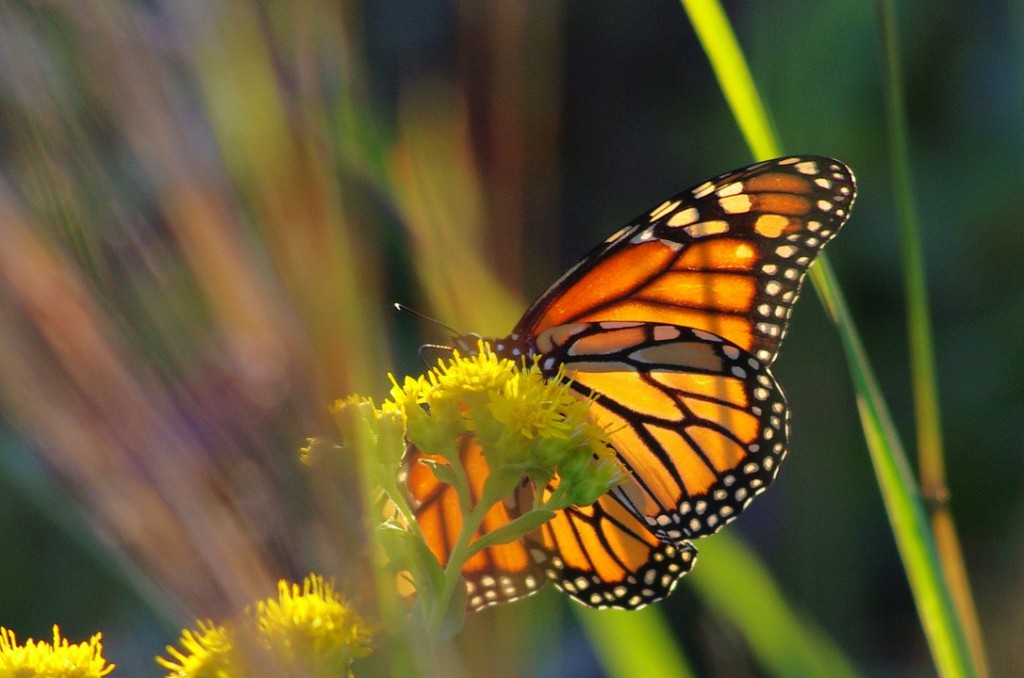Check out the latest edition of our Prairie Breeze newsletter! Inside you can learn about upcoming events, prairie ecology and wildlife, STPS news, and more!
As many of you know, the number of monarch butterflies has been falling in recent years. Each year in late summer and fall, the monarchs of North America east of the Rocky Mountains fly hundreds or thousands of miles to central Mexico’s Oyamel fir forest, where they spend the winter. For the last twenty years the area occupied by the monarchs in Mexico has been measured to give some indication of how many made it. As seen in the graph, this area has been dropping steadily for the last six years, and 2013 saw the area fall to its lowest level ever, only 0.5 hectares (1.2 acres, about 3x the size of the Prairie House and its parking lot), and far below the mean level of about 6.6 hectares (16.5 acres).
According to scientific studies, the main cause of this decline is loss of habitat, especially the milkweed plants where monarchs lay their eggs and which the monarch caterpillar larvae feed on exclusively. Changes in agriculture are thought to underlie the loss of milkweeds, including loss of traditional hedgerows of native vegetation around fields because the fields are planted and plowed right to the edge. Furthermore, the planting of genetically-modified corn and soybeans, which are “engineered” to be resistant to the herbicide Roundup, means that Roundup can be used to literally kill everything but the corn and soybeans. The number of milkweed has fallen dramatically, and the monarchs with them.
Someh ow monarch habitat (milkweed) has to be protected. Individually we can plant milkweeds in our gardens (see Douglas Tallamy’s Bringing Nature Home), and it grows wild in places like Wolf Road Prairie, but the fundamental problem is at the system level of what has become “standard” agricultural practice. That must change if the monarchs we all know and and love are to survive in North America.
ow monarch habitat (milkweed) has to be protected. Individually we can plant milkweeds in our gardens (see Douglas Tallamy’s Bringing Nature Home), and it grows wild in places like Wolf Road Prairie, but the fundamental problem is at the system level of what has become “standard” agricultural practice. That must change if the monarchs we all know and and love are to survive in North America.
–E.J. Neafsey
There has been an explosion of the beautiful sphinx moths this year, and with it many questions as to just what they are. Visitors often mistake this moth for a humming bird!
To learn more, visit these two links from CBS news and Chicago Wilderness and view these pictures from STPS volunteer Ken Moreau. In these great photos of the White-linked Sphinx Moth (its difficult to take photos of this quick insect!), notice their long proboscis and large, distinctive eyes.
Population Of White-Line Sphinx Moths Explodes In Chicago Area – CBS News Chicago
Sphinx Moths:Bird and Bee Impersonators – Chicago Wilderness Magazine
In late summer this native thistle adds a touch of pastel to a prairie dominated by gold and yellow. Its presence throughout the preserve helps to sustain insects dependent on nectar for nourishment. Migrating hummingbirds too find sustenance from the thistle’s array of tubular flowers.
Its leaves are an excellent food source for the hungry caterpillars of the Painted Lady butterfly. Her green barrel shaped eggs can sometimes be found on the topside of the leaves. And as summer wanes and the thistles go to seed, they will attract squadrons of hungry goldfinches. The down of the thistle has been found in the diminutive winter dwellings of the prairie deer mice.
How can you tell the native thistle from the more aggressive alien thistle? Check the underside of a leaf. If it is powdery white or silver-like, then you are looking at a true prairie native. The flower of the non-native is closer in color to purple rather than pink.
Pollinators: Bumblebee, Monarch, Tiger Swallowtail, and Great Spangled Fritillary All of the pictures below were taken at Wolf Road Prairie.
Photos courtesy of Fidencio Marbella
For the last few weeks, the exceedingly tall compass plants have dominated the south prairie and the Prairie House garden. With a taproot that averages 13 ft., thick resin sap, rough textured leaves, and a dense hairy stalk this long-lived perennial is well equipped to endure drought. Its name refers to the general north-south alignment of its basal leaves utilized by Native Americans, pioneers and run-away slaves in determining direction.
–Rita McCabe
Photos by Beth Edwards taken on July 21.
Our resident photographer Fidencio Marbella of the Westchester Library once again has captured the amazing ecology of Wolf Road Prairie through his lens.
In this pair of photos, you will find a wasp of the genus Prionyx (we believe specifically Prionyx parki). Fidencio managed to capture this particular parasitoid capturing a grasshopper.
Wasps of this genus are solitary: rather than living in a hive nest, Prionyx digs burrows underground and lays its eggs on its host. These wasps will sting and paralyze grasshoppers and drag their prey to their burrows where they will subsequently lay their eggs and seal the entrance. Their young will utilize the organism for food, ultimately killing the host.
These photos not only reveal Fidencio’s keen eye for the drama that can occur in nature which usually goes unnoticed by most, but an amazing thread in the web of life.
Written & Researched by
Rita McCabe & Frank Martino
Photographs by
Fidencio Marbella
Sources:
http://www.bugeric.blogspot.com/2010/07/wasp-wednesday-prionyx-thomae.html
https://cdri.org/fieldguides/wasps/taxonomy/prionyx-parkeri.html
 I have been a gardener for most of my life (since I was 13, so gardening for 30 yrs), and the past ten years have been spent specifically gardening for butterflies and then learning all about all of the different species and their fascinating life cycles.
I have been a gardener for most of my life (since I was 13, so gardening for 30 yrs), and the past ten years have been spent specifically gardening for butterflies and then learning all about all of the different species and their fascinating life cycles.
This year I am taking this interest into more organized formats to spread awareness and contribute to their survival. With some other people in Oak Park, we are creating a Wild Ones chapter in the hope of encouraging people to incorporate more natural landscaping which is friendlier to butterflies, birds, and other creatures.
I also decided to participate in a different way in the study of butterflies and to volunteer for the Illinois Butterfly Monitoring Network (IBMN). The IBMN’s purpose is to collect data about butterflies through citizen scientists. Tracking the numbers of butterflies gives useful information about a particular habitat.
Monitors are supposed to visit their assigned site 6-8 times from Memorial Day through August 8; 4 of those visits need to happen before July 20 and data needs to be entered online. Monitors may net the butterflies to obtain specific identification, but I do not feel quite comfortable enough to do that yet. Many of the butterflies we are looking for are ones that I am familiar with and can identify while in flight. Now, some of those similar-looking skippers and small hairstreaks who might move off too fast are another story! Luckily, even unidentified skippers or hairstreaks are still useful data.
This is my first year, and I am so happy to do it at Wolf Road Prairie. It is a special place, and one I look forward to visiting each time. I love seeing the changing landscape and hearing and seeing beautiful birds too. I haven’t seen a Common Yellowt-throat in forever and have never seen a Woodcock but saw one up close when we startled each other. Thanks to all of you that have worked so hard to preserve such a magnificent place.
It’s easy to see the beauty of Wolf Road Prairie in a majestic stag deer or red-tailed hawk, but you would miss some of the most fascinating organisms that call the prairie home. Check out the latest photos from Fidencio Marbella as he captures some of the tiniest residents of Wolf road Prairie
If you found these interesting, be sure to join us for our Insect Safari 2013!